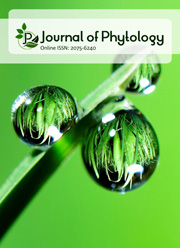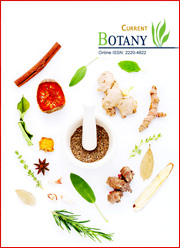In vitro antioxidant and anticancer potential of intra-cellular ethyl acetate extract of marine-derived fungus Talaromyces tratensis SS10
DOI:
https://doi.org/10.25081/jp.2024.v16.8829Keywords:
Talaromyces tratensis SS10, Ethyl acetate extract, GC-MS, Antioxidant, AnticancerAbstract
Marine fungi are well-known for producing structurally distinct secondary metabolites, making them potential sources of novel therapies. The present investigation aims to study the in vitro antioxidant and anticancer potential of intra-cellular crude ethyl acetate extracts of Talaromyces tratensis SS10. In the present study, qualitative and quantitative phytochemical studies of various solvent extracts of T. tratensis have been carried out using standard protocols. Later, ethyl acetate extract of T. tratensis was analyzed for phytochemicals using Gas Chromatography Mass Spectrometry (GC-MS). Further, the antioxidant properties of the T. tratensis ethyl acetate extract have been done by Ferric reducing antioxidant power assay (FRAP). Further, the anticancer potential of this extract has been carried out by MTT assay against human cancer cells such as MDA MB 231, HeLa, and HT-29. Ethyl acetate exhibited a higher yield of chemical extraction than the other solvents used. The GCMS analysis of T. tratensis ethyl acetate extract revealed major phytoconstituents such as N-(1,1-Dimethylpropyl)-2,2,3-trimethylaziridine-1-carboxamide, 1-Undecanol, 5,5 Dimethyl-3-vinyl cyclohex-2-en-1-one, 1,2-Benzenedicarboxylic acid, bis (2-methyl propyl) ester. T. tratensis ethyl acetate extract showed the highest percentage of Fe3+ reduction (48.093±1.469%) at 120 μg/mL, with an IC50 value of 157.26 μg/mL concentration. Furthermore, 100 μg/mL of the extract showed significant cell death rates in cytotoxic assays, indicating a low percentage of viable cells for all three examined cell lines. The T. tratensis ethyl acetate extract has shown a dose-dependent cytotoxic effect against all tested cancer cell lines. The better IC50 value (6.25 μg/mL) was recorded in the case of HeLa cell lines followed by 12.5 μg/mL for both MDA MB 231 and HT-29 cell lines. The presence of bioactive compounds such as Benzeneethanamine, N-[(pentafluorophenyl)methylene]-beta.,3,4-tris[(trimethylsilyl) oxy]-, 1,2-Benzenedicarboxylic acid, bis(2-methylpropyl) ester, and cyclononasiloxane, octadecamethyl- may have contributed to the ethyl acetate extracts’ strong antioxidant and anticancer properties. The current study’s findings show that T. tratensis SS10 has the potential for drug development due to its chemical constituents, which possess various biological activities.
Downloads
References
Al Bratty, M., Makeen, H. A., Alhazmi, H. A., Syame, S. M., Abdalla, A. N., Homeida, H. E., Sultana, S., Ahsan, W., & Khalid, A. (2020). Phytochemical, cytotoxic, and antimicrobial evaluation of the fruits of miswak plant, Salvadora persica L.. Journal of Chemistry, 2020, 4521951. https://doi.org/10.1155/2020/4521951
Baba, S. A., & Malik, S. A. (2015). Determination of total phenolic and flavonoid content, antimicrobial and antioxidant activity of a root extract of Arisaema jacquemontii Blume. Journal of Taibah University for Science, 9(4), 449-454. https://doi.org/10.1016/j.jtusci.2014.11.001
Bako, S. P., Bakfur, M. J., John, I., & Bala, E. I. (2005). Ethnomedicinal and phytochemical profile of some savanna plant species in Nigeria. International Journal of Botany, 1(2), 147-150. https://doi.org/10.3923/ijb.2005.147.150
Bhandari, M. R., & Kawabata, J. (2004). Organic acid, phenolic content and antioxidant activity of wild yam (Dioscorea spp.) tubers of Nepal. Food Chemistry, 88(2), 163-168. https://doi.org/10.1016/j.foodchem.2003.12.027
Bhat, M. P., Rudrappa, M., Hugar, A., Gunagambhire, P. V., Kumar, R. S., Nayaka, S., & Perumal, K. (2023). In-vitro investigation on the biological activities of squalene derived from the soil fungus Talaromyces pinophilus. Heliyon, 9(11), E21461. https://doi.org/10.1016/j.heliyon.2023.e21461
Calabon, M. S., Jones, E. B. G., Pang, K.-L., Abdel-Wahab, M.A., Jin, J., Devadatha, B., Sadaba, R. B., Apurillo, C. C., & Hyde, K. D. (2023). Updates on the classification and numbers of marine fungi. Botanica Marina, 66(4), 213-238. https://doi.org/10.1515/bot-2023-0032
Carroll, A. R., Copp, B. R., Davis, R. A., Keyzers, R. A., & Prinsep, M. R. (2019). Marine natural products. Natural Product Reports, 36(1), 122-173. https://doi.org/10.1039/C8NP00092A
Cavaco, T., Gonçalves, D., Pombo, A., Moiteiro, C., Inácio, M. L., & Faria, J. M. S. (2022). Nematicidal activity of oxygen-containing aliphatic compounds on Bursaphelenchus xylophilus, B. mucronatus and B. fraudulentus. Chemistry Proceedings, 12(1), 55. https://doi.org/10.3390/ecsoc-26-13536
Dai, J., & Mumper, R. J. (2010). Plant phenolics: extraction, analysis and their antioxidant and anticancer properties. Molecules, 15(10), 7313-7352. https://doi.org/10.1590/s2175-97902017000300204
El-Fayoumy, E. A., Shanab, S. M., Hassan, O. M. A., & Shalaby, E.A. (2021). Enhancement of active ingredients and biological activities of Nostoc linckia biomass cultivated under modified BG-11 0 medium composition. Biomass Conversion and Biorefinery, 13, 6049-6066. https://doi.org/10.1007/s13399-021-01509-7
Gangwar, M., Gautam, M. K., Ghildiyal, S., Nath, G., & Goel, R. K. (2015). Mallotus philippinensis Muell. Arg fruit glandular hairs extract promotes wound healing on different wound model in rats. BMC Complementary and Alternative Medicine, 15(1), 123. https://doi.org/10.1186/s12906-015-0647-y
Ganie, S. Y., Javaid, D., Singh, A., Jawaid, F., Anjum, S., Kumari, M., Singh, S. K., Bhagat, M., & Reshi, M. S. (2024). Chemoprofiling and in vitro evaluation of anticancer, antioxidant and antibacterial activities of Asparagus racemosus (Willd). Pharmacological Research-Natural Products, 2, 100015. https://doi.org/10.1016/j.prenap.2024.100015
Garaniya, N., & Bapodra, A. (2014). Ethno botanical and Phytophrmacological potential of Abrus precatorius L.: A review. Asian Pacific Journal of Tropical Biomedicine, 4(S1), S27-S34. https://doi.org/10.12980/APJTB.4.2014C1069
Gonçalves, M. F. M., Esteves, A. C., & Alves, A. (2022). Marine fungi: Opportunities and challenges. Encyclopedia, 2(1), 559-577. https://doi.org/10.3390/encyclopedia2010037
Harborne, J. B. (1973). Phytochemical Methods. London, UK: Chapman and Hall Ltd.
Imhoff, J. F. (2016). Natural products from marine fungi—Still an underrepresented resource. Marine Drugs, 14(1), 19. https://doi.org/10.3390/md14010019
Kumari, N., & Menghani, E. (2021). Evaluation of antibacterial activity and identification of bioactive metabolites by GCMS technique from rhizospheric Actinomycetes. Indian Journal of Natural Products and Resources, 11(4), 287-294.
Lutfia, A., Munir, E., Yurnaliza, Y., & Basyuni, M. (2021). Chemical analysis and anticancer activity of sesterterpenoid from an endophytic fungus Hypomontagnella monticulosa Zg15SU and its host Zingiber griffithii Baker. Heliyon, 7(2), E06292. https://doi.org/10.1016/j.heliyon.2021.e06292
Madhavan, S. A., & Mahadevi, M. (2021) In vitro antioxidant activity of phyto-pharmacological and GC-MS analysis of bioactive compounds present in Eichhornia crassipes leaves ethanolic extract. International Journal of Botany Studies, 6(5), 233-239.
Majoumouo, M. S., Tincho, M. B., Toghueo, R. M. K., Morris, T., Hiss, D. C., Boyom, F. F., & Mandal, C. (2020). Cytotoxicity potential of endophytic fungi extracts from Terminalia catappa against human cervical cancer cells. Journal of Toxicology, 2020, 8871152. https://doi.org/10.1155/2020/8871152
Makhwitine, J. P., Kumalo, H. M., Ndlovu, S. I., & Mkhwanazi, N. P. (2023). Epigenetic induction of secondary metabolites production in endophytic fungi Penicillium chrysogenum and GC-MS analysis of crude metabolites with anti-hiv-1 activity. Microorganisms, 11(6), 1404. https://doi.org/10.3390/microorganisms11061404
Mir, M. A., Parihar, K., Tabasum, U., Kumari, E. (2016). Estimation of alkaloid, saponin and flavonoid, content in various extracts of Crocus sativa. Journal of Medicinal Plants Studies, 4(5), 171-174.
Mosmann, T. (1983). Rapid colorimetric assay for cellular growth and survival: Application to proliferation and cytotoxicity assays. Journal of Immunological Methods, 65(1-2), 55-63. https://doi.org/10.1016/0022-1759(83)90303-4
Moustafa, M. F. M., Alamri, S. A., Taha, T. H., & Alrumman, S. A. (2013). In vitro antifungal activity of Argemone ochroleuca Sweet latex against some pathogenic fungi. African Journal of Biotechnology, 12(10), 1132-1137.
Muthuselvam, D., & Kathick (2021). GC-MS analysis and antimicrobial activities of ethanol alkaloid leaf extracts of Delonix elata L. International Journal of Pharmaceutical Sciences Review and Research, 68(2), 106-113. https://doi.org/10.47583/ijpsrr.2021.v68i02.016
Niu, S., Chen, Z., Pei, S., Shao, Z., Zhang, G., & Hong, B. (2022). Acremolin D, a new acremolin alkaloid from the deep-sea sediment derived Aspergillus sydowii fungus. Natural Product Research, 36(19), 4936-4942. https://doi.org/10.1080/14786419.2021.1913587
Noorjahan, S. K., Rahamtulla, M., & Khasim, S. M. (2023). Phytochemical profiling and GC-MS analysis of leaf extracts of Dendrobium anceps Sw. (Orchidaceae). Journal of Medical Pharmaceutical and Allied Sciences, 12(6), 6230-6240. https://doi.org/10.55522/jmpas.V12I6.5876
Noorjahan, S., Rahamtulla, M., & Khasim, S. M. (2024). Phytochemical analysis of root extracts of Rhynchostylis retusa (L.) Blume from the Eastern Ghats of India. Journal of Phytology, 16, 13-19. https://doi.org/10.25081/jp.2024.v16.8755
Pang, Y., Ahmed, S., Xu, Y., Beta, T., Zhu, Z., Shao, Y. & Bao, J. (2018). Bound phenolic compounds and antioxidant properties of whole grain and bran of white, red and black rice. Food Chemistry, 240, 212-221. https://doi.org/10.1016/j.foodchem.2017.07.095
Rahamtulla, M., Mallikarjuna, K., & Khasim, S. M. (2023). GC-MS analysis and therapeutic importance of leaf extracts of Dendrobium aphyllum (Roxb.) CEC Fischer: An In vitro study. South African Journal of Botany, 153, 62-76. https://doi.org/10.1016/j.sajb.2022.12.011
Robinson, J. P., Suriya, K., Subbaiya, R., & Ponmurugan, P. (2017). Antioxidant and cytotoxic activity of Tecoma stans against lung cancer cell line (A549). Brazilian Journal of Pharmaceutical Sciences, 53(3), e00204. https://doi.org/10.1590/s2175-97902017000300204
Settharaksa, S., Songsangsirisak, C., & Monton, C. (2018). Computer-based estimation of antioxidant activity of Caesalpinia sappan L. Thai Journal of Pharmaceutical Sciences, 42, 102-106.
Shabana, S., & Satya, A. K. (2023). Molecular identification of potent antimicrobial marine fungi from Manginapudi beach (Machilipatnam, India). International Journal of Membrane Science and Technology, 10(2), 3649-3664. https://doi.org/10.15379/ijmst.v10i2.3196
Shabana, S., Lakshmi, K. R., & Satya, A. K. (2021). An updated review of secondary metabolites from marine fungi. Mini Reviews in Medicinal Chemistry, 21(5), 602-642. https://doi.org/10.2174/1389557520666200925142514
Singh, N., Mansoori, A., Jiwani, G., Solanke, A. U., Thakur, T. K., Kumar, R., Chaurasiya, M., & Kumar, A. (2021). Antioxidant and antimicrobial study of Schefflera vinosa leaves crude extracts against rice pathogens. Arabian Journal of Chemistry, 14(7), 103243. https://doi.org/10.1016/j.arabjc.2021.103243
Sivaraj, C., Abhirami, R., Deepika, M., Sowmiya, V., Saraswathi, K., & Arumugam, P. (2019). Antioxidant, antibacterial activities and GC-MS analysis of fresh rose petals aqueous extract of Rosa damascena Mill L.. Journal of Drug Delivery and Therapeutics, 9(4-s), 68-77.
Sun, C., Ge, X., Mudassir, S., Zhou, L., Yu, G., Che, Q., Zhang, G., Peng, J., Gu, Q., Zhu, T., & Li, D. (2019). New glutamine-containing azaphilone alkaloids from deep-sea-derived fungus Chaetomium globosum HDN151398. Marine Drugs, 17(5), 253. https://doi.org/10.3390/md17050253
Sundaram, V., Sadhasivam, S., Chandrasekaran, S., Nanjian R., & Pandian, A. (2021). Strobilanthes heyneanus root extract as a potential source for antioxidant and antimicrobial activity. Future Journal of Pharmaceutical Sciences, 7, 91. https://doi.org/10.1186/s43094-021-00242-2
Togashi, N., Shiraishi, A., Nishizaka, M., Matsuoka, K., Endo, K., Hamashima, H., & Inoue, Y. (2007). Antibacterial activity of long-chain fatty alcohols against Staphylococcus aureus. Molecules, 12(2), 139-148. https://doi.org/10.3390/12020139
Trease, G. E., & Evans, W. C. (1989). Pharmacognsy. (11th ed). London, UK: Bailliere Tindall.
Trease, G. E., & Evans, W. C. (1996). Phenols and Phenolic glycosides. (11th ed). London, UK: Bailliere Tindall.
Yaacob, N. S., Kamal, N. N. N. M., & Norazmi, M. N. (2014). Synergistic anticancer effects of a bioactive subfraction of Strobilanthes crispus and tamoxifen on MCF-7 and MDA-MB-231 human breast cancer cell lines. BMC Complementary and Alternative Medicine, 14, 252. https://doi.org/10.1186/1472-6882-14-252
Published
How to Cite
Issue
Section
Copyright (c) 2024 S. Shabana, R. Venkata Bhargavi, A. Krishna Satya

This work is licensed under a Creative Commons Attribution 4.0 International License.





 .
.